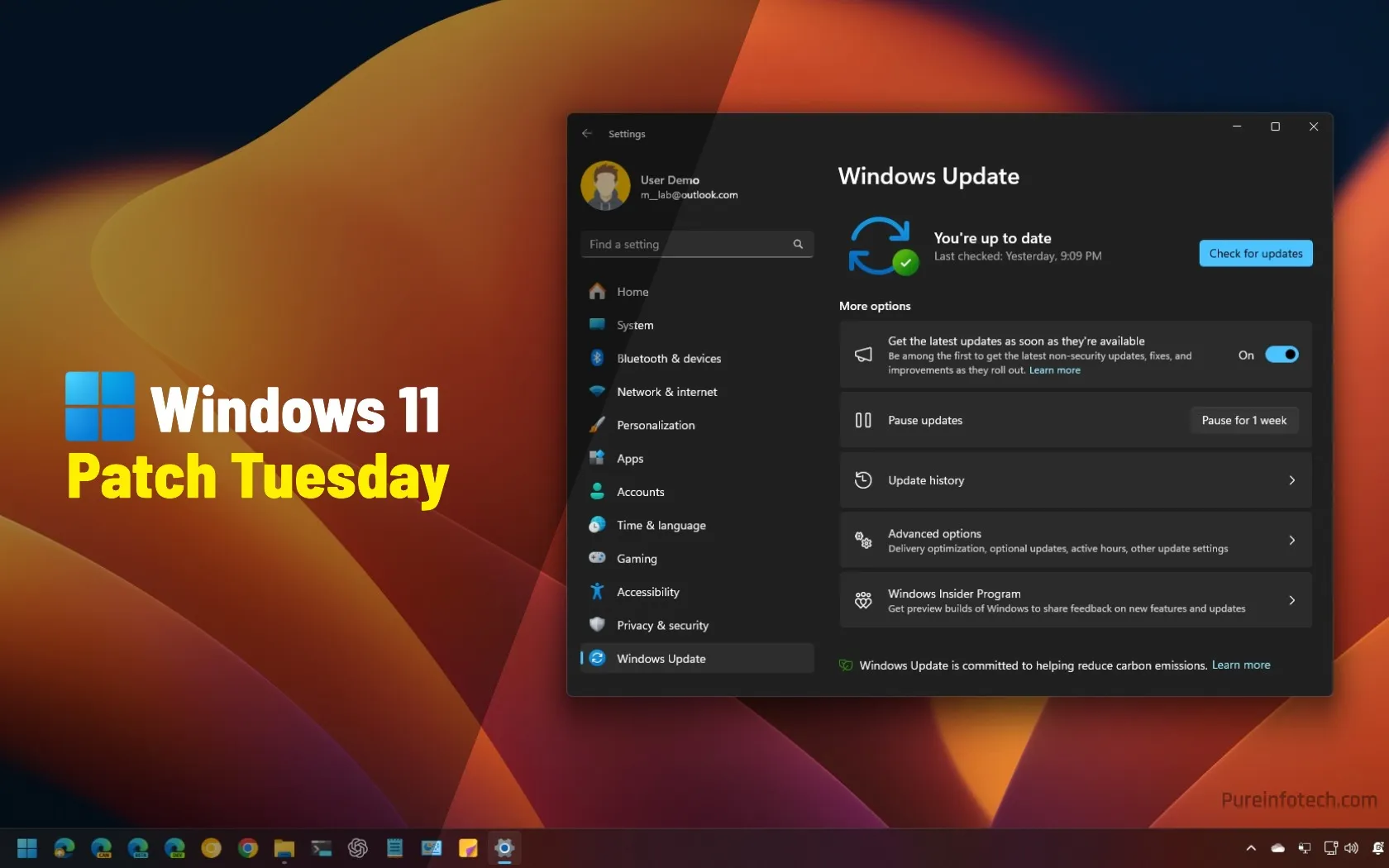KB5055523 for Windows 11 (build 26100.3775) outs as the April 2025 update

UPDATED 4/8/2025: Microsoft rolls out the April 2025 update for version 24H2 with the Windows 11 build 26100.3775 (KB5055523) in the Stable Channel. In addition, builds 22631.5189 and 22621.5189 (KB5053657) are now available for versions 23H2 and 22H2 in the Stable Channel.
In the official notes (notes previously available in the Stable Channel as a preview, in the Release Preview Channel, and for build 26100.3613), Microsoft notes that update KB5055523 improves Live Captions, introduces new changes for the “Home” and “About” pages in the Settings app, rolls out the new Gamepad keyboard layout, updates the CPU usage logic for Task Manager, adds the ability to customize widgets in the Lock Screen, and much more.
Also, according to the official notes (previous notes for build 22631.5126 and build 22631.5116), the update KB5053657 for Windows 11 brings the “Top Cards” feature to the “About” setting page, and for Japanese users, the “Accounts” page will show the first name first.
This update also rolls out the new Gamepad keyboard layout for the touch keyboard, Voice Access support for Chinese users, and pushes various non-security fixes.
Windows 11 24H2 April 2025 update (KB5055523)
These are the non-security fixes and changes expected to arrive with the April 2025 update for Windows 11 24H2.
Windows Search with semantic indexing
Starting with the April 2025 update, the development team is updating the Windows Search feature with semantic indexing. Semantic indexing means that now the system uses AI to help you find files, settings, and apps using natural language anywhere in the system, including in the search box for File Explorer, Taskbar, Start menu, or Search (home).
For example, instead of remembering the document name, you can simply describe it (for example, “Brazil trip budget”).
If you’re in the Settings app, you search for the configuration you want to make rather than searching for the actual setting’s name (for example, “how to change background”).

Microsoft also recommends enabling the “Enhanced” index option in Settings > Privacy & Security> Searching Windows for the best search experience. Currently, this feature works for local files, but in the future, it will work for other storage providers, including OneDrive.
The improvements for search are supported in Chinese, English, French, German, Japanese, and Spanish. Supported file formats include .txt, .pdf, .docx, .doc, .rtf, .pptx, .ppt, .xls, .xlsx for documents and .jpg/.jpeg, .png, .gif, .bmp, .ico for images.
In addition, the update KB5055523 includes another update to the Windows Search experience, which allows you to find images stored in the cloud using natural language.
For example, if you have taken pictures while cycling, you can simply search for “mountain biking” or any type of text that describes the image. The search experience should then show the relevant images.

The ability to search images with natural language is available for those using a Microsoft account and who are connected to the internet. If you have a work or school account, you will only see the matches for the keywords.
It’s important to note that this improvement is gradually rolling out for Copilot+ PCs using the Snapdragon processors. Support for AMD and Intel Copilot+ PCs will arrive in future updates.
Finally, Windows Search has been updated for the European Economic Area (EEA) with better discoverability and merged results in the “All” scope.
In addition, the Bing app’s web search provider in search now opens search results with the default browser rather than on Microsoft Edge.
Live Captions
Starting with build 26100.3775, the development team is improving the communication of live captions and real-time translation for Copilot+ PCs using AMD and Intel processors, expanding translation for more than 44 languages.
Microsoft is also expanding real-time translation for Copilot+ PCs with ARM Snapdragon processors to Chinese (Simplified). Supported languages include Arabic, Bulgarian, Czech, Danish, German, Greek, English, Estonian, Finnish, French, Hindi, Hungarian, Italian, Japanese, Korean, Lithuanian, Norwegian, Dutch, Polish, Portuguese, Romanian, Russian, Slovak, Slovene, Spanish, and Swedish.
Settings with Top Cards
The April 2025 update will add a “Top Cards” view at the top of the Settings app’s “About” page to highlight key hardware specifications, such as storage, graphics card, installed memory, and processor details.

On the “Home” page for commercial customers, the company is adding new cards that will display specific device info and accessibility preferences.
Also, in the “Accounts” section, for Japanese users, the Settings app will now show the user’s first name first instead of last.
Gamepad keyboard layout
On Windows 11 24H2, you will also find a new Gamepad layout for the on-screen keyboard to make it easier to navigate and type using the Xbox controller.

The new layout maps specific buttons, such as X, Y, LB, RB, LT, and others, to common keys like Backspace, Space, Left and Right, and numbers. It also introduces a slightly different keyboard design with a vertical alignment.
Taskbar with dedicated Emoji button
Microsoft is working on a new entry point to access the Emoji panel from the System Tray in the Taskbar. The option appears on the “Taskbar” settings page, and when enabled, you will notice a new icon in the System Tray, depending on the option.
For example, the “Always” option will keep the Emoji button persistent in the System Tray. On the other hand, the “While typing” option will only make the button available when using a text field or when working with a word processing or note-taking application.

Voice Access enhancements
The quality update refines the Voice Access feature, enabling it to understand voice commands more easily without requiring a fixed syntax. For instance, users can now say, “Can you open Edge app,” and the system will recognize and execute the command to open Microsoft Edge. If the system doesn’t understand a voice command, it can now provide real-time suggestions based on the last utterance.

Additionally, Voice Access now supports Simplified Chinese (zh-cn) and Traditional Chinese (zh-tw), expanding its accessibility to a broader user base.
Task Manager with new CPU logic
Windows 11 build 26100.3775 ships an updated version of the Task Manager that makes CPU usage information consistent. You’ll now see the same CPU workload across all pages, matching industry standards.

If you need the previous CPU value, you can show the “CPU Utility” column, which is located in the “Details” tab.
Lock Screen customizable widgets
Starting with the release of update KB5055523, Windows 11 is making changes to the “Lock Screen” settings page. The “Lock screen status” setting will be removed and replaced with a new “Your widgets” setting for devices in the European Economic Area (EEA).
You can turn the “Your widgets” setting on or off to show or hide the widgets in the Lock Screen. When you open the settings, you can add, rearrange, and remove widgets.

It’s important to note that the Lock Screen can now show a variety of widgets, not just weather, watchlist, traffic, and sports.
Furthermore, Microsoft is also introducing a new “Disable Widgets On Lock Screen” policy in the Group Policy Editor to allow administrators to control this feature from Computer Configurations > Administrative Templates > Windows Components > Widgets.

Also, this update gives developers the ability to build dynamic and interactive widgets with existing web content.
Windows Studio Effects System Tray new icon
On devices with a Neural Processing Unit (NPU), you will notice that a new icon will appear to access the Studio Effects from the System Tray when using any application with a Studio Effects-enabled camera.

Microsoft says that the Quick Settings flyout will continue to include the Studio Effects settings.
Other fixes and improvements
The update KB5055523 for Windows 11 also pushes these changes:
Certainly, here’s the complete list with all items, each on a single bullet point:
Microsoft also notes the dedication of the “Suggestions actions” feature, and it’s removing the “Location History” feature that the company used to track your location for Cortana.
Windows 11 23H2 April 2025 update (KB5053657)
These are the non-security fixes and changes expected to arrive with the April 2025 update for Windows 11 23H2 (and 22H2 for Enterprise and Education editions).
Settings with Top Cards
On the “About” page for the Settings app, Microsoft is now working on the “Top Cards” view at the top of the page to highlight some of the key hardware specifications, such as storage, graphics card, installed memory, and processor details.

On the “Home” page for commercial customers, the company is adding new “Your Accounts” cards that will display the accounts connected with the Windows 11 account.
Also, in the “Accounts” section, for Japanese users, the Settings app will now show the user’s first name first instead of last.
Gamepad keyboard layout
In this release, the development team is adding a new Gamepad layout for the on-screen keyboard to make it easier to navigate and type using the Xbox controller.

The new layout maps specific buttons, such as X, Y, LB, RB, LT, and others, to common keys like Backspace, Space, Left and Right, and numbers. It also introduces a slightly different keyboard design with a vertical alignment.
Taskbar with dedicated Emoji button
Microsoft is working on a new entry point to access the Emoji panel from the System Tray in the Taskbar. The option appears on the “Taskbar” settings page, and when enabled, you will notice a new icon in the System Tray, depending on the option.
For example, the “Always” option will keep the Emoji button persistent in the System Tray. On the other hand, the “While typing” option will only make the button available when using a text field or when working with a word processing or note-taking application.

Other improvements
The update KB5053657 for Windows 11 also pushes these improvements:
- Faster File System Notifications: This update adds support for a new Filter Manager function that reduces I/O operations and speeds up directory change notifications for applications.
- Enhanced Asian Language Fonts: The addition of the Noto font family improves web browsing for Chinese, Japanese, and Korean languages, providing clearer and more modern text.
Furthermore, Windows 11 removes the suggested actions that appear when copying phone numbers or future dates.
Other fixes
In addition, Microsoft is rolling out these fixes:
- Remote Desktop: Issues preventing “Get-Help” troubleshooters from running in Remote Desktop sessions have been resolved.
- Reliable Mobile Connectivity: Corrected IOT APN settings for Connected PCs to ensure proper mobile data connections.
- Printer: Resolved an issue where printers using IHV drivers produced incorrect or unwanted text.
- File System: Fixed a system crash issue for users with profiles redirected to network VHD/VHDX drives, and it addressed a stop error that could occur during normal use with profiles redirected to network VHD/VHDX drives.
- Daylight Saving Time (DST): Updated DST for the Aysen region in Chile to reflect the 2025 government change.
No longer rolling out for version 23H2
These are the changes for version 23H2 that Microsoft was previewing for the April 2025 update, but they won’t be available in this release.
File Explorer new improvements
As part of the Windows 11 update KB5053657, File Explorer improves the text scaling support for File Open and Save dialogs and Wizard dialogs when changing the settings from Settings > Accessibility > Text size.
Task Manager with new CPU logic
Windows 11 build 22631.5189 ships an updated version of the Task Manager that makes CPU usage information consistent. You’ll now see the same CPU workload across all pages, matching industry standards.

If you need the previous CPU value, you can show the “CPU Utility” column, which is located in the “Details” tab.
Voice Access enhancements
The quality update refines the Voice Access feature, enabling it to understand voice commands more easily without requiring a fixed syntax. For instance, users can now say, “Can you open Edge app,” and the system will recognize and execute the command to open Microsoft Edge. If the system doesn’t understand a voice command, it can now provide real-time suggestions based on the last utterance.

Installation process
To download and install this quality update for Windows 11, open the “Windows Update” settings, turn on the “Get the latest updates as soon as they’re available” option, and click the “Check for Updates” button. It’s important to note that it may take some time until you see the new features and changes on your computer as Microsoft gradually rolls out improvements.
If you prefer manually installing the April 2025 update for Windows 11, download the update for version 24H2 from the Microsoft Update Catalog website. The update for version 23H2 can be found on this Microsoft support page.
Update March 19, 2025: This content has been updated with new information, and it’s been revised to ensure accuracy.
Update March 24, 2025: Microsoft has released another revision of the update KB5053656 that bumps the build number from 26100.3613 to 26100.3624, which introduces changes for the Windows Search experience.
Update March 26, 2025: Microsoft has released another revision of the update KB5053657, bumping the build number from 22631.5116 to 22631.5126 and bringing the update to version 22H2 as build 22621.5126.
Update March 27, 2025: The company has released the April 2025 update with changes in the build and KB numbers in the Stable Channel.
Update April 8, 2025: Microsoft is now rolling out the Windows 11 April 2025 update for version 24H2, 23H2, and 22H2.
Source link











